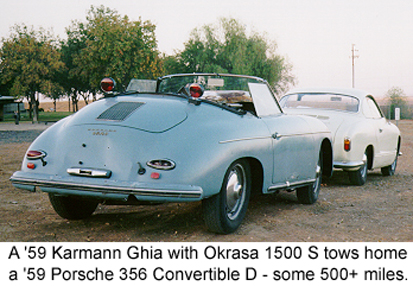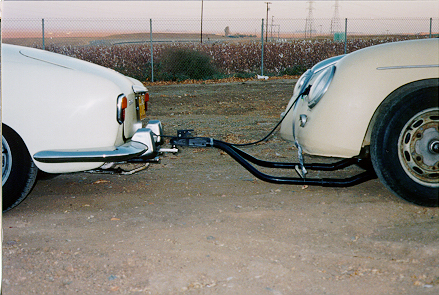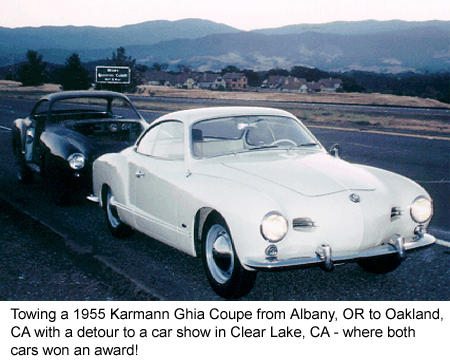Copyright © 2007 - 2025, Coachworks For contact data Click Here.

Copyright © 2007 - 2025
Copyright © 2007 - 2025,
Coachworks For contact data
Click Here.


 Okrasa
engines were made by Oettinger in Germany starting about 1951 and their last
production run was in 1965. They were sold as both turn-key engines, with a
lucky few installed in brand new cars, including coachbuilts like Rometsch and
Buetler.
Okrasa
engines were made by Oettinger in Germany starting about 1951 and their last
production run was in 1965. They were sold as both turn-key engines, with a
lucky few installed in brand new cars, including coachbuilts like Rometsch and
Buetler.
Our experience with Okrasa engines began in 1986 and continues to this day. We manufacture the best valve set and provide unique piston and cylinder options. We supply a handful of parts and we rebuild them for our clients. We have been doing this long enough that we know how to make them very reliable. Because our engines have been regularly seen in going to or coming from shows at high rates of speed - often while towing other vehicles - for over 18 years, our Okrasa engines are literally famous, with clients as far afield as Germany and Britian. Just look at the photographs herein...
Contents:
Okrasa was a supplier of speed equipment for the Volkswagen engine very soon after it inception. Through the years there were lots of various "kits" offered, all of which were intended to be installed using the customer supplied engine. In the early years, VW used a short crankcase in its 25hp and later 35hp engines. Then in 1960, the "40hp" engine was introduced. With it came a new, longer crankcase, thus making obsolete the older designed parts. Okrasa followed suit with "40hp" versions of their parts, but by that time, other vendors such as Gene Berg were beginning to take market share from Okrasa, and they ceased development of new products for this engine. (Interestingly, they later re-surfaced in the late 70s with a dual overhead camshaft offering for the VW Rabbit, which was sold to VW and became the GTI.)
There were quite a few kits offered. The basic kit was to be used on the standard VW engine's "lower end" - from the pistons and cylinders inward, while more comprehensive kits included a long stroke crankshaft and sometimes a different piston and cylinder set.
We will fill in this section as we have more time.
Okrasa engines varry greatly in their abilities because there is so much variety in the parts that go into them. From the factory's stock engine's famous 36hp (sae), Okrasa engines immediately add about half again more - to about 50hp - just by virtue of the improved breathing. When combined with a good camshaft, larger bore, and longer stroke, they are capable of over 75hp - enough to slip a standard 180mm clutch, sometimes enough to slip an improved 180mm clutch! (especially with modern non-asbestos clutch disks) For real-world examples, check out these images:




Convinced yet of the prowess of the Okrasa engine? If not, consider if towing like this would even be thinkable with the stock 36hp VW engine...
When new, Okrasa valves performed well, but just as with the stock VW engine, Okrasa engines suffered the occasional sucked valve due to lack of maintenance. VW solved the problem by designing into their newer engine designs an increase in the diameter of the valve stem. This same strategy is employed by Okrasa valve kits offered by others. The problem with this is that it doesn't enjoy the whole redesign of the valve train VW used. Instead, it increases the weight moved by the cam lobe and returned by the spring - without the benefit of the later VW lifter design - giving a very different performance characteristic and increased wear. Notably, these heavier valves will "float" at much lower RPMs. Much heavier springs must be used just to return these to the original RPM capabilities, and thus increasing wear without adding to performance. The larger valve stem also reduced intake flow somewhat.
In contrast, our Okrasa valve kits offer use of very modern, ultra-high-tech metalurgy developed for racing motorcycles. The use of these modern materials and manufacturing techniques in our valves permit these valves to be of the original dimensions and therefore extremely close to the original weights. They therefore have the same running characteristics as the original. When stronger springs are used, these will actually increase the RPM range before floating occurrs, which is what's desired when you increase spring stiffness.
These valve kits also employ an improved keeper technology. Stock VW and Okrasa valves have a notched keeper groove. This creates what's called an "infinite stress riser" where the valve necks down for the keeper. Instead, our valve kits employ a "radiused keeper" with matching valve spring retainer where a smooth radius is employed, avoiding the infinite stress riser using a lower stress technique instead. None of our valves has yet failed in over fifteen years of service in countless engines.
Finally, these valve kits employ a special spring. These springs provide roughly 20% more spring pressure when installed exactly as stock and also use a thinner wire with fewer revolutions than is typical for this sized spring. The thinner wire and fewer rotations permit a higher-lift camshaft to be used without coil bind. The stronger spring tension means an increase in the RPM at which the valves float by about the same mount. (This can be increased by shimming under the valve spring.) Therefore, an engine that would have floated the valves at 4800 RPM - a typical value - would instead float at about 5750 - a safe value for engines desiring to provide peak power around 5500.
Back in the day, there were many cam grinders around who offered grinds for these early engines, but as the early VW and Porsche engines used a "radiused-follower" design, the shape of the lobe is unique to the era and modern grinds - which use "flat tappet" followers - cannot be used. Of the period units used back in the day, the best two were widely considered to be either the Porsche 1500S grind or the Iskendarian 2J grind - both are very similar.
Unlike every other vendor out there, these sets are made to order. The reasons for this are simple enough. First, they're made in low enough volume that it is possible to do so. Secondly, while nearly identical, Porsche usually uses a 22mm pin while Okrasa typically uses 20mm, and Denzel uses either. Porsche applications require a valve relief in the crown, and Denzel does only in the highest compression ratio applications, while the others do not. All of them have slightly different pin heights. Stocking every possibility means a lot of dollars sitting on the shelf - onerous for a small business. Finally, with the custom-order approach, every engine builder can specify their own compression ratio and not be forced to shim the cylinder bases, cut material out of the head, or play games with valve depth, just to satisfy this vital need.
In addition, because they're made to order, you can mix and match your favorite features! For example, in most years Porsche didn't provide an offset connecting pin because it would mean either that each piston would need valve relief for both sides, or that pistons would only fit in two out of four positions. Another example is pin diameter. Back in the day, metalurgy wasn't as adavnced, so it was felt that a 22mm pin was required for some engines. Today, we can provide the same or better strength in a 20mm pin and reduce mechanical losses due to rociprocating weight.
These are a straight-up copy of the original item, with one little tweak. This product comes with a "too long" cross rod, so it accommodates not only both 36hp and 40hp varieties, but also can accept Porsche-version Solex carburetor arm linkages instead of just the Okrasa ball connection. If you need a shorter cross-shaft, just cut it to length. (Threading on an M6 X 1 die first, in the backwards direction, is recommended to prevent any burrs from cutting.)
We offer reproduction Okrasa fuel lines, too...
Most original Okrasa kits included an oil filter, but not all. It's a bypass type, so it requires a feed of oil and a place to return it. The original strategy was a banjo bolt fitting where the oil pressure switch goes, threading the original oil pressure switch into the rearward end of the bolt and with a hose attaching to the banjo flowing oil to the filter. The original strategy for returning the oil was for the installer to tap a hole into the crankcase in the generator stand area, but later a special hollow stud was provided that replaced the stud that retains the distributor clamp.
Porsche in later years took the opportunity to provide a temperature gauge sending unit in the flow of oil to the filter, so it would be very accurate and respond quickly to oil temperature changes. To do this, their vendor Fuchs (the same people who are famous for the later 911 wheels) produced an aluminum block that was threaded for the sender and provided a similar banjo type fitting to retain this block and feed it oil. This block also was threaded for another banjo fitting, this time feeding oil directly to the filter. This setup requires that the crankcase be drilled and tapped for a verticle feed.We have on many occasions fitted this Fuchs oil fitting setup onto earlier engines - and we can do it for you.
There were quite a variety of units provided with the kits but all were aproximately the same, with the same mounting hardware, fittings, and using the same filter. We have several on hand and can provide your engine a suitable unit.
...To be continued...